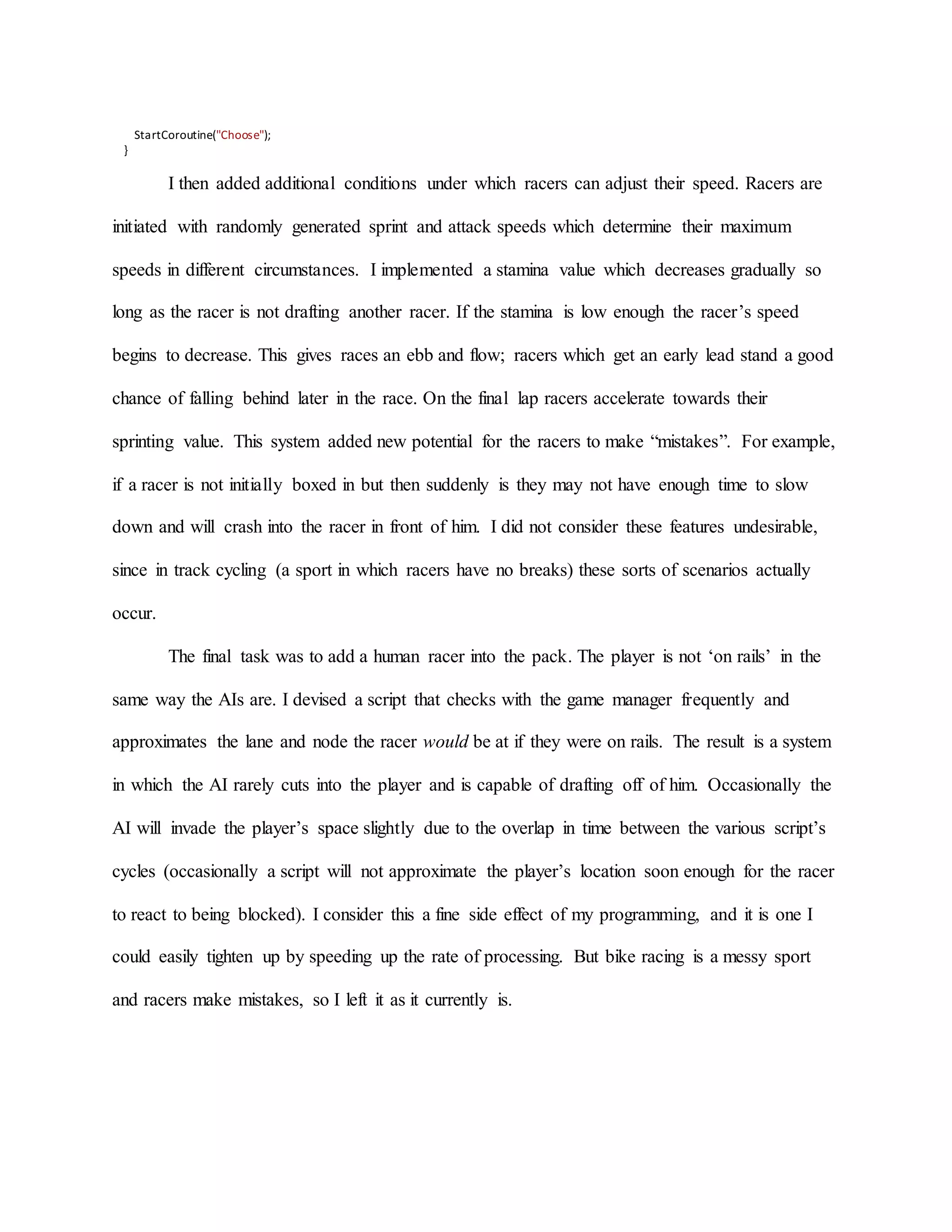Nathaniel Baird designed a pathfinding system from scratch to simulate track cycling racing. He generated 5 concentric lanes around the track represented as nodes. Racers would adhere to their lane and periodically check positions to determine if they should adjust speed or change lanes to pass other racers. Additional conditions like stamina and drafting were implemented. Finally, a human player racer was integrated to race alongside the AI racers in a realistic simulation of track cycling behavior.

![out to be the lowest amount required to properly execute the code responsible for determining
where racers are relative to their opponents (the space between each node is roughly 1 bike
length).
lane2 =new Vector3[94];
zVal =-8.75f;
upperCurveAdd =0;
lowerCurveAdd =0;
startX +=1;
for (int i =0; i <lane2.Length;i++)
{
if(i < 20)
{
zVal +=2.1875f;
lane2[i]= new Vector3(startX,0, zVal);
}
if(i >= 20 && i <35)
{
upperCurveAdd -=12f;
Vector3 dir =Vector3.Normalize(upperCurve.transform.position-lane2[19]);
dir.x *=-1;
dir =Quaternion.AngleAxis(upperCurveAdd,Vector3.up) *dir;
lane2[i]=upperCurve.transform.position+(dir *startX);
}
if(i >= 35 && i <67)
{
zVal -=2.1875f;
lane2[i]= new Vector3(-startX, 0, zVal);
}
if(i >= 67 && i <82)
{
lowerCurveAdd -=12f;
Vector3 dir =Vector3.Normalize(lowerCurve.transform.position -lane2[66]);
dir.x *=-1;
dir =Quaternion.AngleAxis(lowerCurveAdd,Vector3.up) *dir;
lane2[i]=lowerCurve.transform.position+(dir *startX);
}
if(i >= 82)
{
zVal +=2.1875f;
lane2[i]= new Vector3(startX,0, zVal);
}
}
The lane is entirely two-dimensional with no concern whatsoever for the y-value (or
height) of the nodes. Rather than worry about the geometry of a banked oval I established the y-
value of each racer by capturing the location of the track mesh below. The racer’s y-value, then,
equals the y-value at which a raycast intersects the track.](https://image.slidesharecdn.com/c2b00fd3-3c7e-42d3-840e-960889a0cdf5-160705191048/75/Velo-Write-Up-2-2048.jpg)
![With this system in place racers were capable of traveling around the track in their
respective lanes. The next task was to create systems for determining when racers should adjust
their speed or change lanes.
A central game manager keeps track of every racer in an array. Periodically racers run
through the array and check the nodes and lanes that other racers occupy. The first component in
the check determines whether another racer in the same lane occupies a node slightly larger than
the one currently occupied by the racer (a node is occupied if it is the node which the racer is
currently traveling toward). If the racer determines that they are blocked it does a check on the
lane above. If the lane is clear the racer moves up for a pass, if it too is occupied the racer
decreases its speed until it matches the racer in front. If the racer is not blocked in front (or is
blocked by a racer going the same speed or faster) the racer checks the lane below, and if safe
transitions into it. The following is the code which checks to see if a racer has room to move up a
lane.
IEnumeratorCheckUp()
{
yield return new WaitForSeconds(timer);
bool front =false;
bool safe =true;
for (int i =0; i <racerCount; i++)//check ifraceris above
{
racerA=gameManager.GetComponent<RacerPositions>().racers[i];
if(racerA.GetComponent<TrackRingPathing>().lane ==GetComponent<TrackRingPathing>().lane+1)
{
if(racerA.GetComponent<TrackRingPathing>().nodeInArray >=currentNode&&
racerA.GetComponent<TrackRingPathing>().nodeInArray -1 <currentNode)
{
safe =false;
}
if(racerA.GetComponent<TrackRingPathing>().nodeInArray <=currentNode&&
racerA.GetComponent<TrackRingPathing>().nodeInArray +1 >currentNode)
{
safe =false;
}
}
}
if (safe ==true)
{
GetComponent<TrackRingPathing>().MoveUp();
}](https://image.slidesharecdn.com/c2b00fd3-3c7e-42d3-840e-960889a0cdf5-160705191048/75/Velo-Write-Up-3-2048.jpg)
